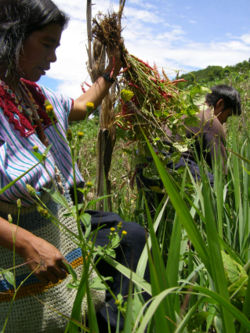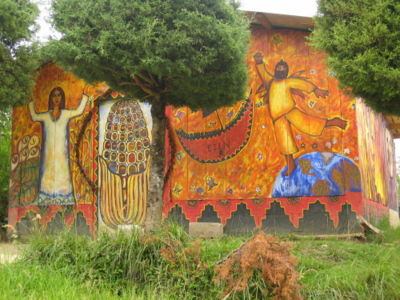Milpa agriculture: Difference between revisions
imported>Joe Quick (pipe links to squash) |
imported>Joe Quick |
||
| Line 18: | Line 18: | ||
==The ritual life of the milpa== | ==The ritual life of the milpa== | ||
Maize | Maize and the agricultural cycle, with which it is closely associated, have a millennia old importance in Mesoamerican myth, ritual and culture. | ||
[[Image:Oventic_mural.jpg|thumb|400px|right|One of many ornate murals in the Zapatista community of Oventic in Chiapas, Mexico. One need not look far to discover the intimate connection between maize and people in Mesoamerican culture. Here, a human head wearing the characteristic Zapatista ski mask appears on every kernel.{{photo|Steev Hise}}]]In modern ritual practice, the agricultural cycle is filled with ceremonies that reaffirm the salience of corn as a cultural motif. | [[Image:Oventic_mural.jpg|thumb|400px|right|One of many ornate murals in the Zapatista community of Oventic in Chiapas, Mexico. One need not look far to discover the intimate connection between maize and people in Mesoamerican culture. Here, a human head wearing the characteristic Zapatista ski mask appears on every kernel.{{photo|Steev Hise}}]]In modern ritual practice, the agricultural cycle is filled with ceremonies that reaffirm the salience of corn as a cultural motif. | ||
Revision as of 20:12, 20 October 2007

Milpa agriculture is a form of swidden agriculture that is characteristic of Mesoamerica. Traditionally, a "milpa" plot (from the Nahuatl word for "corn field") is planted with maize, beans, and squash and might include a variety of other plants. These plots are planted for two or three years and then allowed to lie fallow for some years in order to restore the fertility of the soil. Milpa agriculture varies somewhat by region and it has changed in a variety of ways in different areas but it remains an important part of life for millions of people throughout Mesoamerica.
Maize and beans
Maize and beans, which are the staples of the Mesoamerican diet, complement each other in terms of the health of the fields as well as the health of the people who eat them. Maize requires high levels of nitrogen in the soil to grow properly and quickly depletes the soil if planted alone. Bean plants (genus Phaseolus), on the other hand, are high in nitrogen and their presence extends the life of the maize plot significantly by helping to keep nitrogen levels healthy. One might say that the maize repays the debt it owes to the beans by providing stalks for the bean plants to cling to as they grow. Squashes, generally grown between the rows of maize stalks, also figure into this symbiotic relationship, as they cover the ground in between the rows of corn and help to keep weeds down.
Maize and beans also compliment each other nutritionally. If eaten alone, one would need to consume large amounts to fulfill human dietary requirements but when eaten together, they achieve "protein complimentarity."[1] That is to say, a person needs less total food if the two are eaten together. This diet is further supplemented by several varieties of squash and other foods that are planted along side the maize and beans. In many areas, the "Mesoamerican trio" (maize, beans and squash) is complemented by wild or semi-domesticated plants that grow in and around the milpa.

Planting and harvesting
Milpas are traditionally cultivated using the swidden, or "slash and burn" system. The forest is cut, allowed to dry and then burned. The left over ashes are then mixed into the soil as a fertilizer. Maize and beans are planted together in the same hole while squash is planted separately, in between the rows of maize. Other cultigens may be planted in a separate section of the field or scattered among the maize.
The fields must be weeded several times throughout out the season. This is backbreaking work, especially in areas where a milpa is likely to be planted on the slope of a mountain several hours walk from home and it is usually done mostly by hand with the help of machetes and hoes. Later in the season, weeding is less needed, as the broad leaves of the squash plants keep unwanted plants to a minimum and the maize grows out of reach of the weeds.
Beans and squash are harvested as they ripen. As the maize ripens, a few elotes (or fresh cobs) may be picked to be eaten right away but most of the plants are bent near the top and the cobs are allowed to dry in the field. Once they are dry, they are collected and stored for later use in traditional Mesoamerican foods like tortillas and tamales. The dry stalks are often collected and sold at market as fodder for animals.
The weeds and left over corn stalks from the previous season will be burned to prepare the fields for planting for one or two more years but then they will be left to fallow for as much as ten or more years. This practice has been abandoned in many areas because of the shortage of land that is available to many families. Instead, animal dung or ashes from the hearth at home may be added to those mixed into the soil and many farmers have turned to industrial fertilizers that allow them to cultivate the same plot year after year.
The ritual life of the milpa
Maize and the agricultural cycle, with which it is closely associated, have a millennia old importance in Mesoamerican myth, ritual and culture.

In modern ritual practice, the agricultural cycle is filled with ceremonies that reaffirm the salience of corn as a cultural motif.
Modern trends
One consequence of the changes in land ownership patterns introduced through Spanish colonial society and some of the agrarian reforms carried out by the modern states in the region is that many families do not own enough land to produce all of the food that they need in a year. Consequently, the practice of fallowing the fields has disappeared or nearly disappeared in many areas. Today, many farmers use chemical fertilizers to increase their fields’ production and engage in other economic activities to earn enough money to provide for their families.
Many farmers have also converted their fields to other crops. Wheat was a popular cash crop in highland Guatemala until some time in the 1980s, when tariffs were lowered and the market was flooded with grain from the U.S., driving down prices. Today, cash crops destined for export to the U.S. include broccoli, snow peas, Brussels sprouts, and carnations.
Notes
- ↑ Edward F. Fischer and Carol Hendrickson. 2003. Tecpán Guatemala: A Modern Maya Town in Global and Local Context. ISBN 0-8133-3722-4
